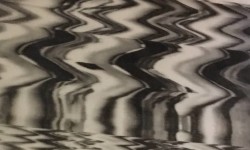I enjoyed the processes I used during this project. I think the lack of control I had over the images the photocopier produced was really interesting as it meant that every piece I made was almost trial and error and no two pieces were the same, even though every piece originated from the same initial sketches and collages I created at the beginning. It also gave me the ability to build an expansive archive of imagery very quickly.
The huge amount of pages I produced meant that I had a variety of options to work with when putting the book together. I played with the theme of distortion while creating this body of work, inspired initially by the way history has been told and retold, branching into the idea that stories have the potential to change drastically over time. I tried to organise the pages in a way that reflects this idea by putting pages with cleaner more recognisable motifs at the front and heavily distorted pages at the back.
I opted not to use any additional text and to let the visuals and the composition of the pages speak for themselves. This meant that the reader had no definitive context when looking through the book, but this was purposeful because I thought it would be interesting to see what themes or ideas a reader would formulate without any prompts. This might also kind of make a readers experience with the book more personal and specific to them.
To improve the durability of the book and to make looking trough it a more pleasant tactile experience I covered each page in clear plastic book covering before binding it with metal clips.
The group critique of our work was something I was excited about because it would show me realistically how successful I was at portraying a theme or concept through images alone. I would conclude that I was relatively successful in the way that my peers noted that the pages got progressively more distorted and distortion was the overlying theme. The smaller more specific underlying themes weren’t all noticed but my subtle use of sound waves to allude to speech was picked up on.
If I was to do a second version of this book I would definitely explore the use of text alongside the imagery. Even though I liked that I produced something that is quite open to interpretation I think that by doing so I missed the opportunity to dig even further into the concept and uncover more complex ideas that could only be fully or properly told with the use of text.
I might also bind the book more interestingly if I were to produce it again. Although I might still decide not to bind the pages permanently in place, as another thing that was discussed during the group critique that I found quite interesting was that the books pages had the ability to be removed and rearranged – which I think related perfectly to the way a story of the past has the potential to be edited and rearranged over time.
